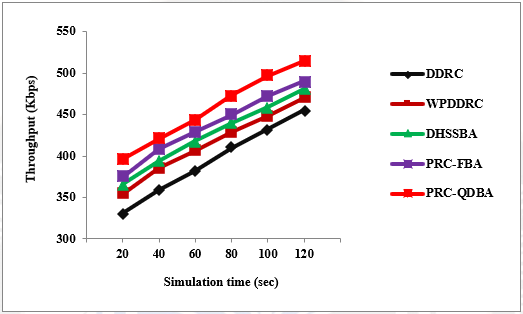Quality of Service Aware Dynamic Bandwidth Allocation for Rate Control in WSN
Main Article Content
Abstract
Different types of data can be generated by Wireless Sensor Networks (WSNs) in both Real-Time (RT) and Non-RT (NRT) scenarios. The combination of these factors, along with the limited bandwidth available, necessitates careful management of these categories in order to reduce congestion. Due to this, a Proficient Rate Control and Fair Bandwidth Allocation (PRC-FBA) method has been created that prioritizes certain types of traffic and creates a virtual queue for them.In PRC-FBA, the Signal-to-Noise and Interference Ratio (SINR) model is applied to the problem of bandwidth allocation in WSN in an effort to find a compromise between equity and performance. Then, a brand-new bandwidth utility factor is defined with regard to equity and effectivenes. The FBA method in PRC-FBA is devoped for only improving throughput, but not considering delay. However, delay is the main factors for trasnmiitng NRT packets. This paper offers a PRC with Quality of Service (QoS) aware Dynamic Bandwidth Allocation (PRC-QDBA) approach for allocating bandwidth while prioritizing packets based on their traffic classes. This model employs a QoS associated dynamic bandwidth allocation strategy which efficiently distributes the unused time slots among the required nodes. The distribution technique is performed based on hierarchical manner utilizing a parent-child association of tree topology. The parent node receives traffic indication maps (TIMs) from the children nodes and adopts them to allocate time slots based on their demamds. If the parent node is unable to allocate the required slots, it creates a TIM that indicating the demands and transfer it to its immediate parent node. This increases the entire performance rate of RT traffic. Furthermore, this model assures the packet forwarding for previously accepted flows by allowing node transmission based on ancestral connection capabilities. Finally, simulation results demonstartes that the suggested model significantly increases the throughput and delay for bandwidth allocation while also enabling QoS support for RT traffic in WSNs.
Article Details
References
F. Mazunga and A. Nechibvute, “Ultra-low power techniques in energy harvesting wireless sensor networks: Recent advances and issues,” Scientific African, vol. 11, pp. 1-14, 2021, doi: 10.1016/j.sciaf.2021.e00720.
D. Pandey and V. Kushwaha, “An exploratory study of congestion control techniques in wireless sensor networks,” Computer Communications, vol. 157, pp. 257-283, 2020, doi: 10.1016/j.comcom.2020.04.032.
S. A. Shah, B. Nazir and I. A. Khan, “Congestion control algorithms in wireless sensor networks: trends and opportunities,” Journal of King Saud University-Computer and Information Sciences, vol. 29, no. 3, pp. 236-245, 2017, doi: 10.1016/j.jksuci.2015.12.005.
C. Y. Wan, S. B. Eisenman and A. T. Campbell, “CODA: congestion detection and avoidance in sensor networks,” In Proceedings of the 1st International Conference on Embedded Networked Sensor Systems, pp. 266-279, 2003, doi: 10.1145/958491.958523.
C. Wang, B. Li, K. Sohraby, M. Daneshmand and Y. Hu, “Upstream congestion control in wireless sensor networks through cross-layer optimization,” IEEE Journal on Selected Areas in Communications, vol. 25, no. 4, pp. 786-795, 2007, doi: 10.1109/JSAC.2007.070514.
A. A. Rezaee, M. H. Yaghmaee and A. M. Rahmani, “Optimized congestion management protocol for healthcare wireless sensor networks,” Wireless Personal Communications, vol. 75, no. 1, pp. 11-34, 2014, doi: 10.1007/s11277-013-1337-z.
S. Brahma, M. Chatterjee, K. Kwiat and P. K. Varshney, “Traffic management in wireless sensor networks: decoupling congestion control and fairness,” Computer Communications, vol. 35, no. 6, pp. 670-681, 2012, doi: 10.1016/j.comcom.2011.09.014.
S. K. Swain and P. K. Nanda, “Priority based adaptive rate control in wireless sensor networks: a difference of differential approach,” IEEE Access, 7, pp. 112435-112447, 2019, doi: 10.1109/ACCESS.2019.2935025.
Mohan, D. ., Ulagamuthalvi, V. ., Joseph, N. ., & Kulanthaivel, G. . (2023). Patient-Specific Brain Tumor Segmentation using Hybrid Ensemble Classifier to Extract Deep Features. International Journal of Intelligent Systems and Applications in Engineering, 11(4s), 127–135. Retrieved from https://ijisae.org/index.php/IJISAE/article/view/2579.
G. Vanitha, P. Amudha and S. Sivakumari, “Analysis of Algorithms to Control the Congestion by Improve Energy Efficiency in WSN,” ECS Transactions,vol. 107, no. 1, pp. 1-8, 2022, doi: 10.1149/10701.5191ecst.
M. A. Kafia, J. Ben-Othman, A. Ouadjaout, M. Bagaa and N. Badache, “REFIACC: Reliable, efficient, fair and interference-aware congestion control protocol for wireless sensor networks,” Elsevier Jour. on Comp Communications, vol. 101, 2016, doi: 10.1016/j.comcom.2016.05.018.
M. P. Shelke, A. Malhotra and P. Mahalle, “A packet priority intimation-based data transmission for congestion free traffic management in wireless sensor networks,” Computers & Electrical Engineering, vol. 64, pp. 248-261, 2017, doi: 10.1016/j.compeleceng.2017.03.007.
Prof. Nikhil Surkar. (2015). Design and Analysis of Optimized Fin-FETs. International Journal of New Practices in Management and Engineering, 4(04), 01 - 06. Retrieved from http://ijnpme.org/index.php/IJNPME/article/view/39.
M. Gholipour, A. T. Haghighat and M. R. Meybodi, “Congestion avoidance in cognitive wireless sensor networks using TOPSIS and response surface methodology,” Telecommunication Systems, vol. 67, no. 3, pp. 519-537, 2018, doi: 10.1007/s11235-017-0356-6.
S. B. Tambe and S. S. Gajre, “Novel strategy for fairness-aware congestion control and power consumption speed with mobile node in wireless sensor networks,” In Smart Trends in Systems, Security and Sustainability, Springer, Singapore, pp. 85-111, 2018, doi: 10.1007/978-981-10-6916-1_9.
M. S. Morshed, M. Hossen and M. M. Rahman, “Dynamic hybrid slot-size bandwidth allocation algorithm for reducing packet delay and jitter variation of real time traffic in EPON,” Optik, vol. 183, pp. 523-533, 2019, doi: 10.1016/j.ijleo.2019.02.076.
M. Manjul, R. Mishra, K. Singh, M. Abdel-Basset and P. H. Thong, “Single rate based extended logarithmic multicast congestion control,” Journal of Ambient Intelligence and Humanized Computing, pp. 1-13, 2019, doi: 10.1007/s12652-019-01340-z.
S. Qu, L. Zhao and Z. Xiong, “Cross-layer congestion control of wireless sensor networks based on fuzzy sliding mode control,” Neural Computing and Applications, pp. 1-16, 2020, doi: 10.1007/s00521-020-04758-1.
Juan Lopez, Machine Learning-based Recommender Systems for E-commerce , Machine Learning Applications Conference Proceedings, Vol 2 2022.
V. Srivastava, S. Tripathi, K. Singh and L. H. Son, “Energy efficient optimized rate based congestion control routing in wireless sensor network,” Journal of Ambient Intelligence and Humanized Computing, vol. 11, pp. 1325-1338, 2020, doi: 10.1007/s12652-019-01449-1.

